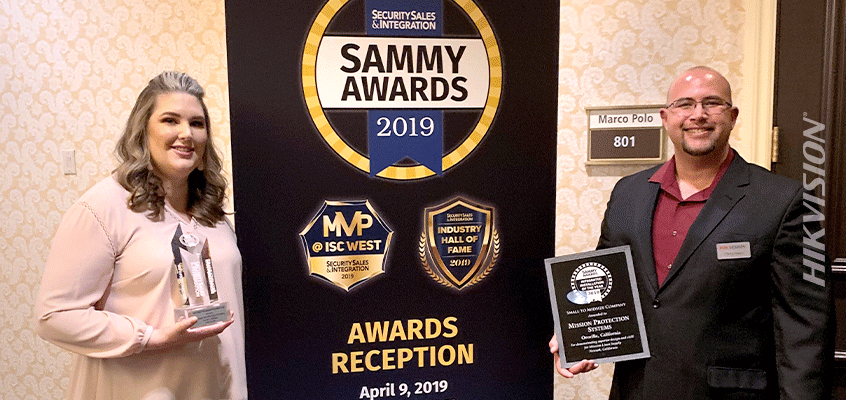Mission Protection Systems, intégrateur de systèmes Hikvision, remporte le prix SAMMY du SSI pour l’application thermique Hikvision et obtient la mention « meilleure installation intégrée de l’année » à ISC West 2019

Susan Smith, directrice des ventes et marketing pour la Mission Protection Systems et le directeur régional des ventes d’Hikvision, Chris Haun, posent avec les Sammy Awards.
L’intégrateur de systèmes Hikvision Mission Protection Systems a remporté un prix SSI SAMMY à ISC West 2019 pour son projet d’installation de caméras réseau thermiques à l’usine de Mission Linen Supply, un fournisseur de linge et d'uniformes de Newark, en Californie. Le gagnant du prix a été annoncé le mardi 9 avril à l’occasion de la 24e remise des prix SAMMY de Security Sales & Integration (SSI), qui récompense les revendeurs et les intégrateurs pour leurs réussites en matière de marketing, de commerce et d’installation, et qui a eu lieu à l’hôtel-casino Venetian Resort de Las Vegas.
Mission Protection Systems a reçu le prix SAMMY pour la « meilleure installation intégrée de l’année » dans la catégorie PME pour l’installation de sept caméras bullet thermiques Hikvision à l’usine de Mission Linen Supply, à Newark. Les caméras réseau thermiques étaient installées à des endroits stratégiques de manière à pouvoir surveiller l’intérieur et le périmètre des zones contenant des sacs de linge, où les risques de surchauffe sont les plus élevés. Dotées d’une alarme de température et d’un algorithme avancé de détection d’incendie, les caméras réseau thermiques Hikvision surveillent la température et les incendies jour et nuit, même lorsque l’usine est fermée.
« Mission Protection Systems est ravie et honorée de voir son travail récompensé par un prix SAMMY. Grâce à un travail d’équipe, l’installation des caméras thermiques uniques et personnalisables de Hikvision a permis d’assurer la surveillance de la température et des incendies à Mission Linen Supply, de répondre aux besoins précis du client et de l’aider à protéger ses actifs. Être reconnue pour une installation aussi innovante est très gratifiant », a déclaré Susan Smith, directrice des ventes et du marketing à Mission Protection Systems.
Les caméras détectent les hausses de température et envoient un signal au panneau d’alarme d’intrusion. En retour, cela transmet un signal de supervision vers un poste de surveillance central hors site et hébergé par Mission Protection Systems, qui appelle Mission Linen Supply pour l’aviser d’une hausse de température. À ce stade, le client peut demander au poste de surveillance d'envoyer le service d'incendie et de voir les images captées par les caméras à distance depuis son téléphone ou son ordinateur.
Pour en savoir plus sur les applications thermiques, passez voir Hikvision au kiosque 18037 à ISC West le jeudi 11 avril, de 10 h à 17 h, et le vendredi 12 avril, de 10 h à 15 h.
